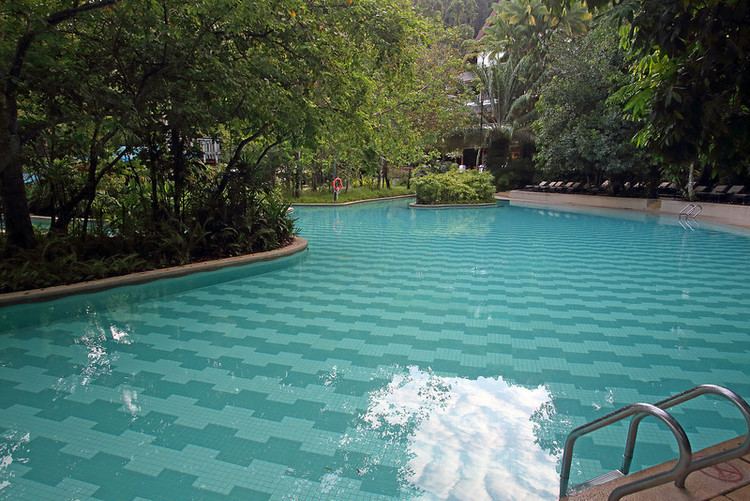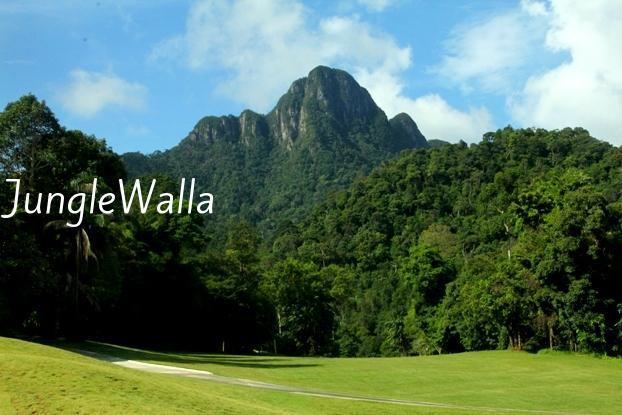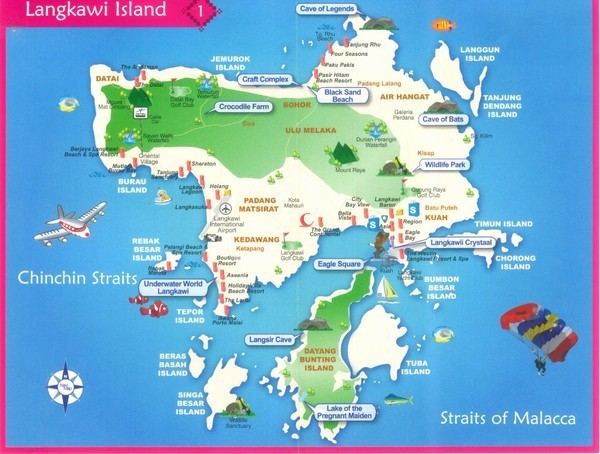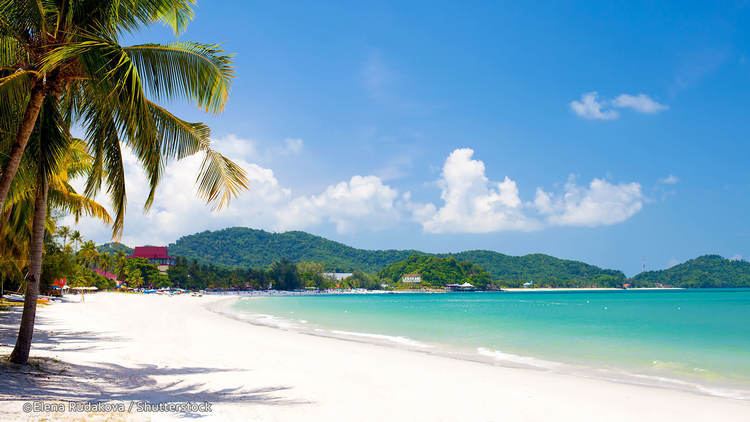Country Malaysia Area 478.5 km2 Mayor En. Zabudin bin Hat | State Kedah Population 64,792 | |
 | ||
Points of interest Langkawi Cable Car, Tanjung Sanctuary, Pulau Payar | ||
Islands Pulau Dayang Bunting, Pulau Songsong, Pulau Bidan, Pulau Telor, Pulau Langkawi, Pulau Tuba Similar Payar Island, Tioman Island, Redang Island | ||
Map of Langkawi
Langkawi, officially known as Langkawi the Jewel of Kedah (Malay: Langkawi Permata Kedah), is an archipelago of 104 islands in the Andaman Sea, some 30km off the mainland coast of northwestern Malaysia. The islands are a part of the state of Kedah, which is adjacent to the Thai border. On 15 July 2008, Sultan Abdul Halim of Kedah had consented to the change of name to Langkawi Permata Kedah in conjunction with his Golden Jubilee Celebration. By far the largest of the islands is the eponymous Langkawi Island with a population of some 64,792, the only other inhabited island being nearby Tuba Island. Langkawi is also an administrative district with the town of Kuah as largest town. Langkawi is a duty-free island.
Contents
- Map of Langkawi
- Place you should go and visit in langkawi
- Places to visit in langkawi
- Etymology
- History
- Geography
- Climate
- Administrative divisions
- Demographics
- Federal parliament
- State assembly seats
- Economy
- Tourism
- Islands and beaches
- Cable car and Sky Bridge
- The Kilim Karst Geoforest Park The Kilim River
- Activities
- Shopping
- Transportation
- Secondary
- Tertiary
- Media
- Television
- FM Radio
- Twin towns Sister cities
- Delicious street food at the night market langkawi malaysia gopro
- References

Place you should go and visit in langkawi
Places to visit in langkawi
Etymology

The name Langkawi is thought to have existed by the early 15th century, although in the 16th century the island of Langkawi was also marked on maps variously as Langa, Langka, Lansura, and Langapura.

There are many suggestions for the origin of the name of Langkawi. According to one interpretation, Langkawi means island of the reddish-brown eagle in colloquial Malay. The Malay word for eagle is helang - which is shortened to "lang", while kawi is the name of a red stone used as a chalk to mark goods. This interpretation was used to create the landmark sculpture of an eagle as the symbol of Langkawi at Dataran Helang (Eagle Square) in Kuah.

Some believed that Langkawi is the same as or related to the Lanka or Langkapuri mentioned in Indian sources. This ancient name Lanka (or Lankapura and Lankapuri) is found in Indian literature from an early period (named in Ramayana as the city of the demon Ravana), although the identification of the original Lanka is not certain. "Puri" or "Puram" in Sanskrit means a town or city. The name Langkawi is also thought to be related to Langkasuka, an old kingdom thought by some to have links with Kedah. Some also thought that Langkawi means "many beautiful islands", langka being a Sanskrit word meaning "beautiful" while wi means "many".
In 2008, the then sultan of Kedah, Abdul Halim Mu'adzam Shah, conferred the title of Langkawi Permata Kedah, meaning "Langkawi, the Jewel of Kedah", upon the island as part of his golden jubilee to impress upon tourists that Langkawi is part of Kedah.
History
Langkawi had long been at the periphery of, but closely associated with, the domain of the old kingdom of Kedah. Legend tells of a great snake ular-besar, the custodian of the Langkawi Islands, to which a new king of Kedah must sacrifice a virgin daughter whenever he first ascended the throne, or when a war was declared with another state.
The island of Langkawi was recorded in history by various travellers to the region. It was called Long-ya-pu-ti (龍牙菩提) in the 14th century by the Yuan Dynasty traveller Wang Dayuan, and when the Ming Dynasty admiral Zheng He visited the region the island was marked as Long-ya-jiao-yi (龍牙交椅) in his map. In the 15th century, it was known to Acehnese as Pulau Lada or Pepper Island as they came over to plant pepper. In 1691, the French general Augustin de Beaulieu recorded going to the island of "Lancahui" (Langkawi) to buy pepper, and de Beaulieu was required to obtain a license from Kedah's heir apparent then in Perlis before the penghulu or chief of Langkawi would sell pepper to him.
Langkawi was historically home to seafarers, such as the Orang Laut (sea people) originally from the southern part of the Malay peninsula, as well as pirates and fishermen. It had been thought to be cursed for a couple of centuries - according to local legend, in the late 18th century, a woman named Mahsuri was wrongfully accused of adultery and put to death, and she placed a curse on the island that would last for seven generations. Not long after Mahsuri's death, in 1821, the Siamese army invaded Kedah, and attacked Langkawi. In the first attack, the locals decided to burn down the granary at Padang Matsirat to starve and drive out the Siamese army. The Siamese nevertheless finally captured the island in May 1822, killed its leaders, and many of the islanders were taken as slaves, while others were forced to flee. Before the Siamese invasion, there was an estimated island population of 3,000–5,000, and only a small proportion was left after the invasion.
The island was recaptured from Siamese rule in a campaign against the Siamese in 1837. In 1840–1841, the Sultan of Kedah, who went into exile after the Siamese attacks, was allowed to return by the Siamese, and the population of Langkawi islands recovered afterwards mainly due to settlement of immigrants from Sumatra. However, the Orang Laut who fled after the Siamese attacks did not returned. In 1909, the islands came under British rule under the Anglo-Siamese Treaty of 1909. The middle of the channel between Tarutao and Langkawi would become the Siamese border, and Tarutao would be part of Siam while all the Langkawi islands to the south would come under British rule. During the Second World War, Siam took control briefly as Malaya fell to the Japanese.
Langkawi had been a haven for pirates which affected the northern part of the Malacca Strait. In a series of operations, between December 1945 and March 1946, the British cleared the pirates' land base in Langkawi and Tarutao. The British continued to rule until Malaya gained its independence in 1957.
Langkawi remained as a quiet backwater until 1986, when the then Prime Minister Mahathir Mohamad decided to transform it into a major tourist resort, helping to plan many of the islands buildings himself. The island rapidly grew as a tourist destination, and by 2012, it had received over 3 million tourists a year.
Geography
Langkawi, a cluster of 99 islands separated from mainland Malaysia by the Straits of Malacca, is a district of the state of Kedah in Northern Malaysia and lies approximately 51 km west of Kedah. The total land mass of the islands is 47,848 hectares. The main island spans about 25 km from north to south and slightly more for east and west. The coastal areas consist of flat, alluvial plains punctuated with limestone ridges. Two-thirds of the island is dominated by forest-covered mountains, hills and natural vegetation.
The island's oldest geological formation, the Machinchang Formation, was the first part of South-East Asia to rise from the seabed in the Cambrian period more than half a billion years ago. The oldest part of the formation is observable at Teluk Datai to the north-west of the island, where the exposed outcrop consists of mainly sandstone (quartzite) in the upper parts and shale and mudstone in the lower parts of the sequence. In fact, the best exposure of the Cambrian rocks (541 to 485 Ma) in Malaysia is the Machinchang Formation _ made up of quartzose clastic formations _ in Langkawi; the other known correlative, the Jerai Formation, crops out near to the west coast of Kedah on the mainland Peninsular. Geologically speaking, all these rocks are located within the Western Belt of Peninsular Malaysia which is thought to be part of the Sibumasu terrane.
Climate
Langkawi receives more than 2,400 mm (94 in) of rain annually. Langkawi has a true dry season from December until February while March to November is a long raining season. September is the wettest month, when it normally receives more than 500 mm (20 in).
Administrative divisions
Langkawi District is divided into 6 mukims, which are:
Demographics
Only four of the 99 islands are inhabited - Langkawi (the main island), Tuba, Rebak and Dayang Bunting. The population is approximately 99,000, around 65,000 of them in Langkawi, of which 90% are Malays. The other ethnic groups consist mainly of Chinese, Indians and Thais.
Islam is practised primarily by ethnic Malays. Other major religions are Hinduism (mainly among Indians), Buddhism (mainly among Chinese and Thai) and Christianity (mostly Chinese).
Standard Malay is the official language and is used in formal occasions. English is widely spoken and understood by the locals. Most natives speak a Langkawi variant of Kedah Malay with minorities speaking Chinese, Siamese and various Indian languages.
Federal parliament
Langkawi district representatives in the Federal Parliament of Malaysia (Dewan Rakyat):
State assembly seats
List of Langkawi district representatives in the State Legislative Assembly (Dewan Undangan Negeri)
Economy
An agro-based economy of paddy and rubber cultivation and fisheries is being overtaken by a tourism-driven economy.
The Northern Corridor Economic Region (NCER) development program is a Malaysia Government initiative to accelerate economic growth in the north of Peninsular Malaysia – encompassing the states of Perlis, Kedah, Penang and the north of Perak. The target for NCER is to achieve increased tourism receipts per visitor from MYR1,890 (US$600) in 2005 to MYR3,034 (US$963) by 2012.
Annual tourist expenditure is targeted to increase from MYR9.0 billion (US$2.86 billion) in 2005 to MYR21.8 billion (US$6.9 billion) in 2012 and MYR64.5 billion (US$20.4 billion) in 2020.
Tourism
On 1 June 2007, Langkawi Island was given a World Geopark status by UNESCO. Three of its main conservation areas in Langkawi Geopark are Machincang Cambrian Geoforest Park, Kilim Karst Geoforest Park and Dayang Bunting Marble Geoforest park (Island of the Pregnant Maiden Lake). These three parks are the most popular tourism area within Langkawi Geopark. In 2014 Unesco allegedly issued a 'yellow card' warning threatening the status of the Geopark.
The Langkawi UNESCO Global Geopark status was due for renewal in 2015, of which upon thorough inspection by the appointed Geopark Inspectors, Langkawi was issued the Certificate of Membership dubbed the Green Card by Asia Pacific Geoparks Network, under the auspices of the Global Geopark Network (GGN).
Tourists can enter the island via ferry from Kuala Kedah, Kuala Perlis and Penang. Or by domestic flight from Kuala Lumpur International Airport (KUL) via Malaysia Airlines, AirAsia, Malindo Air, Rayani Air, or Subang Sultan Abdul Aziz Shah Airport (SZB) via Malindo Air and Fireflyz providing budget connection to the island. International connection is available from Singapore via Tigerair and AirAsia, as well as from Guangzhou via AirAsia.
Islands and beaches
There are two main island areas: the Southern Islands, with a heavier tourist population and the islands to the north east which are more secluded with little tourist traffic. Langun Island has a fresh-water lake like Pregnant Maiden Lake only without the tourists and has Sand Spit Beach on its south-facing orientation. Dendang Island next to it forms a bay used by Langkawi sailing yacht tour operators.
Some of the most popular beaches are Pantai Cenang, Pantai Tengah, Burau Bay, Pantai Kok, and Datai Bay. Pantai Cenang beach has long stretches of fine white sand. It has a number of restaurants and bars for evening entertainment, several hosting live music and for watching the sun set. The beach is lined with tall coconut and casuarina trees. Pantai Tengah is separated from Cenang by a small cape. It also faces the setting sun and has hotels than bars, making it less busy in the evening. Burau Bay, fringed by rocky outcrops, is visited by migratory birds. Pantai Kok quiet beach has a backdrop of limestone hills. Datai Bay has a combination of forests and sea, its white sandy beach is backed by forest.
Cable car and Sky Bridge
The Langkawi Cable Car takes visitors up to the peak of Gunung Mat Chinchang, where the Langkawi Sky Bridge is located. The Sky Bridge was closed in 2012 for maintenance and upgrading, but reopened in February 2015. An inclined lift called SkyGlide that would takes visitors from the top station to the Sky Bridge was completed in late 2015.
The start of cable car ride is located in the Oriental Village where there are a number of attractions, including a 3-Dimensional art museum known as Art in Paradise.
The Kilim Karst Geoforest Park (The Kilim River)
This area actually consists of three river estuaries that stretch from the Kisap village approximately 10 km to Tanjung Rhu and they are all interconnected. They are rich in wildlife and tourists may see hairy nosed sea otters, brown winged kingfishers, monitor lizards and swimming macaque monkeys. There is also a bat cave within the Geoforest Park, a favorite stop for tourists. Limestone, inherently porous, forms caves and there are several in the mangroves. One of Langkawi's natural beauty spots is the Pirate Lagoon just outside the river. Technically this is a collapsed cave (hong) consisting of a cave entrance from the sea emerging into a hidden lagoon with towering, limestone escarpments and smaller caves.
Activities
With Langkawi surrounded by the sea, there are various water-based activities to indulge in. For those that love cruises, there are various cruises that can accommodate for individuals that love the morning sun or individuals that would like to have dinner on a yacht. Tourists can also choose to go for island hopping tours with different options:
Shopping
Transportation
The island of Langkawi can be reached by sea and air. The Langkawi Jetty Point connects the island to main destinations like Kuala Perlis, Kuala Kedah, Penang and Tamalang. There's also ferry service to Satun town and to Ko Lipe island in Thailand. The Langkawi International Airport is one of 7 international airports in Malaysia and connects the island to Kuala Lumpur, Singapore, Penang and also Subang. The main island is well-served by a number of roads.
Secondary
Tertiary
Media
The television and radio in Langkawi can be received from Gunung Raya.and RTM Kuah.
Television
FM Radio
Twin towns – Sister cities
Langkawi currently has one sister city:
